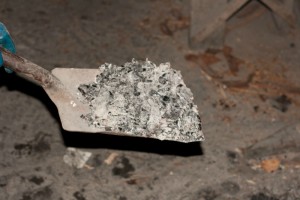Operating your fireplace safely doesn’t end when the fire goes out. Proper ash disposal and removal is an important part of fireplace safety. By taking the time to properly remove ashes, homeowners can rest assured that they are minimizing the risk of accidental fire as well as helping their fireplace to operate with maximum efficiency.
Are ashes dangerous?
Most homeowners view ashes as the least dangerous part of any fire. While the ashes themselves are not dangerous, hidden coals and embers in the ashes can be. “Wood ashes retain enough heat to ignite other combustible materials for several days,” meaning that they can reignite long after the fire has gone out. Because of this, it is important that homeowners learn how to properly dispose of their ashes.
Improper ash disposal
Unfortunately, some of the most common ways that homeowners dispose of their ashes are also some of the most unsafe. The following common ash removal methods should not be used.
- Pouring water onto a fire: While this may seem like an easy way to quickly extinguish a fire, it creates a hard to clean mess and can damage your firebox.
- Dumping ashes into trash cans or dumpsters: Any hot coals hidden in the ashes can ignite surrounding trash.
- Using cardboard boxes or paper bags to store or transport ashes: Combustible containers such as paper or cardboard can ignite if any coals are left in the ashes.
- Using a vacuum to clean ashes out of the firebox: Even vacuums with a HEPA filter can cause ashes to go airborne. Because they are so fine, ashes can coat and stain carpets, walls, or furniture.
Proper ash disposal
The first step is proper ash disposal is ensuring that no hot coals or embers remain in the ashes. To do this, fires should be allowed to naturally extinguish overnight, periodically stirring the ashes to eliminate hot spots. Next, ashes should be transferred into a designated ash container. Ash containers should be made of metal, have a tight fitting lid, and should not sit directly on the ground. Likewise, avoid storing ash containers near combustible materials such as in garages or sheds to further minimize the risk of accidental fire.
Alternative uses for ashes
After taking the time to properly remove and store their ashes, many homeowners are left wondering what to do with them. Thankfully, there are several alternative uses for ashes.
- Fertilizer: Small amounts of ash “improves root health and strengthens the very cellular structure of plants, helping them resist all kinds of stresses,” says Julia Gaskin.
- Bug repellant: Keep slugs and snails away from gardens by sprinkling ashes around the edges of the plot. The ash acts as a natural repellant to many insects while also enriching the soil.
- De-icer: Ashes can be used as a natural alternative to salt or gravel on icy walkways during the winter. However, if you sprinkle your driveway or sidewalk with ash, be sure to wipe your feet before coming inside!

